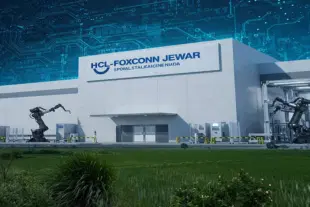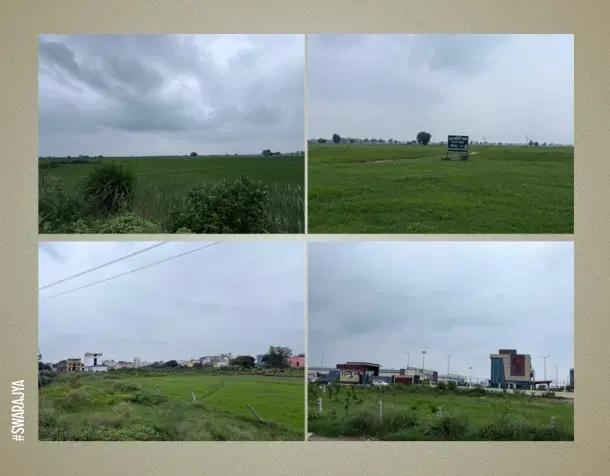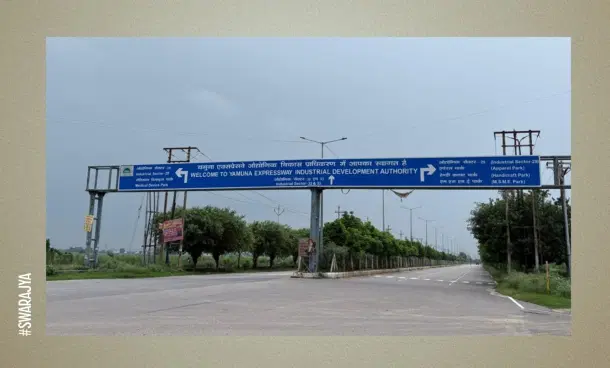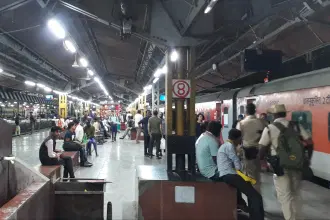Uttar Pradesh
From Farmland To Fab Hub: Jewar's Transformation With HCL-Foxconn's Semiconductor Facility
Ankit Saxena
Sep 17, 2025, 07:21 PM | Updated 07:23 PM IST
Save & read from anywhere!
Bookmark stories for easy access on any device or the Swarajya app.


Around 80 kilometres from Delhi, a cluster of once-quiet villages in the Jewar subdivision of Gautam Buddh Nagar, is rapidly changing. These villages, located along the 165-kilometre Yamuna Expressway that connects Noida to Agra, are now at the centre of major developmental attention.
Once largely rural and lacking in proper roads, sanitation, water supply, and other infrastructure, this area is now emerging as a hub for some of India’s largest planned industrial and infrastructural developments.
These villages have lived through times with narrow dirt tracks—or no roads at all—and barely any basic amenities. The Yamuna Expressway, launched over a decade ago, was the first turning point. It gave both connectivity and recognition," says Vikas, a resident of Birampur village.
His village lies right next to the industrial sectors being developed by the Yamuna Expressway Industrial Development Authority (YEIDA), on farmlands acquired from local villagers.
Although the Yamuna Expressway brought initial recognition to the region, focused attention on Jewar only began around 2017. This shift happened with the announcement of the Noida International Airport and the planned development of industrial and residential sectors in the area.
Since then, Jewar has steadily become a focal point for both government bodies and industry stakeholders. The Uttar Pradesh government approved the Master Plan-2041, which now guides all industrial and urban development in this region.
Now, apart from the airport, various industrial sectors are being developed across the Yamuna Expressway in designated zones. These include specialized parks such as the Apparel Park, Electronic Components Manufacturing Park, Toy Park, and Medical Device Park.
“Things began to change drastically after 2017, once work on the Noida International Airport began. Wide roads were built, sectors were planned, and basic services started reaching our area,” Vikas adds.
Also Contributing To India’s Chip-Making Aspirations
Now, Jewar is set to play a crucial role in India's developing semiconductor ecosystem.
The Union Cabinet, in May 2025, approved a new semiconductor facility to be established here by a joint venture between HCL Group and Foxconn.
The plant, to be developed at an investment of Rs 3,700 crore. This will be the sixth approved under the India Semiconductor Mission.
The approved facility will be spread over 48 acres in Sector-28 of the YEIDA region. It will manufacture display driver chips used in mobile phones, laptops, automobiles, and other devices. It will have a production capacity of 20,000 wafers per month, translating to an output of up to 36 million units monthly. Production is slated to begin by 2027, as per Economic Times report.
Foxconn, the world’s largest electronics manufacturer and a key supplier for Apple’s iPhones, is expected to use this plant not just to meet India’s growing demand but also to supply globally.
Union Minister Ashwini Vaishnaw stated, “Once this unit is operational, a display panel manufacturing plant is also likely to follow, meeting up to 40 per cent of India’s demand.”
The plant’s arrival has further driven real estate and economic activity in the region, speeding up the development wave set in motion by the airport project.
Once a quiet rural corner, the area is now emerging as a key hub in India’s industrial landscape — and is set to play a major role in the country’s semiconductor push.
“The semiconductor facility has completely changed how people see this region. It’s one of the most important and high-impact industrial projects here. It will be a major driver of future growth. Now everyone wants a piece of land in this region.” Vikas adds.
The Way This Region Has Changed
The region is now firmly on the radar of investors and developers.
For an area that, according to locals, once lacked proper roads, sanitation, and even access to basic necessities, it is now in the national spotlight—and attracting interest from global investors as well.
“Imagine from where these villages once were, and now we hear that one of the biggest airports is being developed here. Industries are coming in, and now that semiconductor plant too.”, says a local resident of Chak Birampur village.
“All of this, we hear, will contribute to India’s next wave of development,” The village lies in the zone where the upcoming semiconductor facility is being set up.
“It is not just the development and economic benefits received locally. We are also happy that this region is growing in a way that contributes to the state and to the entire country.”, he adds.
Many villagers recall how, in the past, migration strained their family ties. “Most people here are involved in agriculture. But those who wanted salaried jobs had to go to Delhi or Noida because even educational opportunities were limited here,” says an elderly man from Tirthal, a village nearby.


“That too is beginning to change. With more industries coming in, youth here are turning toward to explore paths to employment in the region. It is also bringing new knowledge and awareness to our villages, beyond just agriculture.”, he adds.
Uttar Pradesh’s renewed focus on industrial growth has shifted attention toward developing fresh hubs of manufacturing and innovation across the state.
With support from state government policies like the UP Industrial Policy 2022 and the Semiconductor Policy, regions like Jewar have emerged as key zones.
These policies have made it easier to attract large-scale investments by offering incentives and easing regulatory hurdles, while the state’s infrastructure setup further supports the development of a comprehensive industrial ecosystem.
As outlined in the YEIDA Master Plan 2041, the area is being developed across industrial, commercial, institutional, and group housing sectors. Close to 90 per cent of the land has been earmarked for industrial use—with a strong focus on warehousing, logistics, and dedicated manufacturing zones.
Sectors 8, 10, 28, 29, 32, and 33 are among those designated as industrial zones hosting these various clusters.
Many of these industries are already operational, employing workers from within the region and also attracting a workforce from outside.


“Most of the companies are setting up factories, it means that our young people don’t have to migrate anymore. They can work here, live at home, and still earn. It is also helping women, who are now able to access job opportunities nearby.”
Now, with advanced industries like electronics and manufacturing setting up shop, especially with the HCL-Foxconn semiconductor facility in the works, the region is being seen as ideal for technical graduates and skilled professionals.
At the same time, beyond direct employment, villagers are seeing many indirect income opportunities emerging.
“Many people are now moving into construction and real estate,” says a young resident at the Jewar MLA’s office.
Dhirendra Singh, the Member of the Uttar Pradesh Legislative Assembly from Jewar, has played a key role in mediating between farmers and the state government during the land acquisition process.
Ensuring smooth land acquisition is crucial, as Jewar stands to gain significantly from the ongoing and upcoming development plans.
“In our village, some are upskilling themselves in real estate management and construction trades because they believe this sector has a real future here.”, he adds.
Others are exploring opportunities in rental housing, hospitality, local retail, as well as activities related directly or indirectly to support these industries.
“These upcoming advanced industries have made locals more aware of new business opportunities. Retail activity has picked up too, with shops now catering to the growing number of workers,” says a villager living near Sectors 33 and 34.
The arrival of these industries has also pushed for improvements in public services.
Attention is now turning toward education and healthcare institutions. “Earlier we had to go to Noida or Greater Noida for medical needs,”, he adds. “Now, a healthcare facility is being proposed right here. Three degree colleges are also coming up nearby.”, he adds.
At present, the region resembles the early years of Gurugram, two decades ago.
Much like Gurugram’s transformation, which began with Maruti Udyog Limited and expanded with the arrival of the services sector, this region holds immense potential to drive Uttar Pradesh’s growth in the manufacturing space and contribute meaningfully to the state’s economic trajectory.
Meanwhile, with planned metro connectivity and better infrastructure, the area is also expected to avoid many of the challenges that have plagued Gurugram’s rapid urbanisation.
Jewar continues to transform from an agricultural outpost into one of India’s most promising industrial frontiers—one with the potential to reshape the economies of both Uttar Pradesh and the nation.





